There are a large number of several parasites that may exist in a person's internal organs or inhabit your skin and hair.Including these parasites can be helminths.
Helminths- The general name of parasitic worms that live in the human body, other animals or plants.
According to the World Health Organization statistical data, more than 4.5 billion people worldwide are infected with several parasites, many of which are helminths.
The official statistics of the Russian Federation observe an increase in the incidence of basic helminties in some territories of the Russian Federation entities, in particular: ecinococcosis, opistochiasis.In various territories, the incidence indicators of enterobiosis and ascaridosis remain at a high level.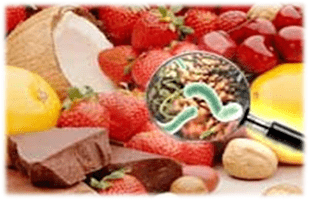 There are many ways to enter the human body, however, one of the most common ways of infection is infection through food products.Poorly washed vegetables, fruits or herbs, insufficiently fried or cooked meat, fish, poultry, incorrectly treated foods can lead to helminth infection.
There are many ways to enter the human body, however, one of the most common ways of infection is infection through food products.Poorly washed vegetables, fruits or herbs, insufficiently fried or cooked meat, fish, poultry, incorrectly treated foods can lead to helminth infection.
You can be infected in case of inadequate storage of the finished product, for example, storing candy -free candy can lead to helminth infection, whose eggs can enter the finished product using flies or other insects.
Let's try to find out which helminths transmitted with food and are most common in our country and how to minimize the risk of infection with them.
Supreme (cat, liver, lanceolate, etc.)
Fasciolosis
In humans, more than 40 types of subsidies can parasite, while the location of helminths in the body can be very different - liver, light and blood vessels.
The hepatic borrower is the causative agent of fascioliase and affects the liver and gallbladder.
A person was used when using vegetable garden crops to water water from open lagoons.
Patients have general symptoms of intoxication - weakness, decreased appetite, nausea, headaches.Allergic reactions may occur in the form of itching on the skin or hives, asthmatic attacks.
An increase in parasite size may lead to a violation of bile flow in the duodenum and the occurrence of mechanical jaundice signs.Patients have pain in the right hypochondrium.Then skin renewal can be observed and the feces are discolored.
OPISTORCHOZ
Optional -causing agents are a cat saucer.
Human infection occurs when raw fish, not sufficiently processed or salty.
The clinical manifestations of opistchiasis are characterized by a significant variety.It depends on the individual characteristics of the body as well as the intensity and duration of infection.The number of parasitic worms can float in a wide variety: from unique parasites to several dozen and even hundreds.Repeated use of infected fish leads to an increase in infection and aggravation of clinical manifestations.Clinically, the disease can be accompanied by an increase in temperature in patients, the appearance of urticaria, itching on the skin, muscles and joint pain.Patients may have pain in the right hypochondrium, a sensation of heavy stomach, nausea.
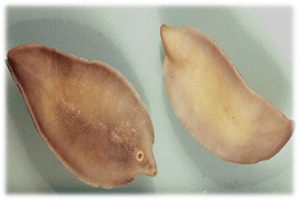
Paragonism
The main causative agent of paragonimosis in humans is a pulmonary bacon.
The causative agent of the disease enters a person's gut when eating crustaceans living in areas, where there is a focus of the disease and migrates through the body: they penetrate the intestinal wall in the abdominal cavity and then enter the pleural cavity through the diaphragm and then the pulmonary tissue.Longer larvae can also penetrate other organs and tissues.The location of the parasite in the brain is especially dangerous.The location imposts the parasite happens in one third of the infected people and is usually the cause of death.
At the early stage of the disease, when pulmonary bacon migrates only throughout the body, the disease continues almost asymptomatic.Sometimes small allergic reactions, itching on the skin are possible, less frequently - abdominal pain, jaundice.Once the parasite reaches the final location, patients have pronounced symptoms of pulmonary damage: constant cough with abundant sputum, severe pain in the chest.During the disease, several complications may occur, for example, pneumothorax - air entering the pleural cavity.Often, in patients, pneumonia or pleurisia (inflammation in the pleural cavity) develop.
Tape worms
Cestod Worms - A group of tape -shaped parasitic worms and consisting of a different number of anatomically isolated segments - swallow.The dimensions of the worms range from a few millimeters to 10 to 15 meters or more.At the front end of the worm, the head is located, which is a parasite fixation organ to the human intestinal mucosa.Helmint is fixed to the intestinal wall using different devices - rounded suction glasses or slit, hooks.
Difficulty
The causative agent of Dipillobotriosis is a large tape that lives in a person's gut.
The tape is large from 12 to 15 meters or more, and the number of thousands of segment segments.
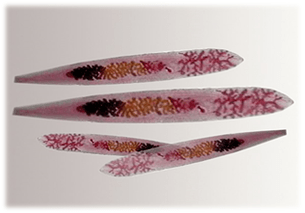
Human infection occurs when not sufficiently processed, newly -bundled, poorly chopped, malfunctioned, and manure, chopped fish, as well as when using newly salted fish.The clinical picture is due to the mechanical effect of helminth on the intestinal mucosa and the absorption of nutrients.Patients with diolobotriosis complain of pain and crashing in the stomach, nausea, vomiting.Often there is a stool disorder.With the simultaneous parasitization of various worms, intestinal obstruction may occur.
The tape adSoxizes vitamin B12 on its surface, and this leads to a violation of the formation of red blood cells in the patients' body and the occurrence of anemia.Patients have skin pallor, weakness, badly.
Toninchinose
The causative agent of shading is a bull tape, located by a person's small intestine and can reach a length of 10 meters.
People are infected with tusiarinchos when eating infected cattle (fried or cooked, string, chopped meat).
Tusirinchose usually continues asymptomatic and is by chance when the patient sees a parasitic segment in his stools, or detects them in bed or in clothing.During the interrogation, the patient may complain that he recently feels weakness, increased fatigue, sleep disturbance, abdomen -torn skin, pain in the right venerable region, vomiting, chair violation.
As a complication of tusirinchos in patients, acute appendicitis or intestinal obstruction may occur.
Teniosis
The causative agent of tuniosis is a pork chain located in a person's small intestine and can reach a length of 3 meters.
The pork tapeworm can be located in various organs and tissues.
Relatively favorably cysticcosis with location in subcutaneous tissue or skeletal muscles.
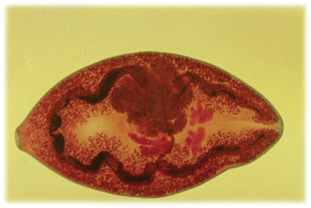
With ocular cystiscose, patients complain of distorting the form of objects, tear and a gradual decrease in visual acuity.
Brain cystiscose is difficult and usually ends with a fatal result for a sick person.
Echinococcosis
The causative agent of echinococosis is an echinococcus, located in the liver and lungs and can reach a length of 5-6 meters.
For a person, Echinococcus infection is possible with the use of uninsy garden crops, vegetables or fruits, which can be parasitic eggs.
Clinical manifestations of the disease depend on the size, quantity and location of Echinococcus bubbles in the patient's body.With the location of Echinococcus in the liver, patients complain of gravity and pain in the right hypochondrium as well as the yellow of the skin as a result of a violation of the exit of the bile.Large cysts, squeezing the door vein, lead to a violation of venous blood output from the gut and the appearance of ascites - fluid accumulation in the abdominal cavity.
When located in the lungs, dry cough and pain during breathing are worried.
Alveococcosis
The causative agent of alveococcosis is alveococcus, which affects the liver with possible metastases subsequent to various other organs.The size of alveococcus does not exceed 5 mm.
A person is infected with eating uninsy wild herbs and forest fruits, as well as eating products, washing that is performed on an open lake.
At the early stage of the disease, patients are concerned about weakness, bad -staring, headache, itching on the skin.In the future, complaints of a sense of weight in the right hypochondrium may appear;Vomiting, diarrhea, swelling, especially after eating fatty foods.
The patient's condition worsens significantly when Alveococcus enters other organs.The most dangerous metastases of the brain, kidneys, lungs.In the context of inhibition of the patient's immune system, bubbles are very often suppuration, abscesses occur in the internal organs, which further aggravates the patient's condition and may be the cause of death.
Round worms (nematodes)
Round worms are one of the most numerous types of worms.The diseases caused by round worms are called nematodes.
The nematodo body has a shaped or threaded shape, bows at the ends, rounded in the cross section, the size of the worm round can be different, but more often does not exceed 0.5 meters.
Adhesive
The causative agent of Ascariase is Ascaris, parasitizing in a person's small intestine.The size of mature worms can reach 40 cm.
The main and only possible mechanism of human infection with ascaridosis is the fecal oral.Uns washed vegetables or fruits, water, household items, dirty hands are the main transmission factors.And if you remember the mechanical carriers of eggs - insects, the list of products in which Askaride eggs can be extremely large.
The clinical manifestations of ascariase depend on the amount of parasites in the small intestine.Most of the time, an individual lives in a person's gut - so the disease is often asymptomatic.
In the presence of several individuals in the body, patients have signs of body poisoning with worms.Patients complain of dizziness, headache, sleep disturbance.There is a feeling of heavy stomach, unstable chair.By parasitizing a large amount of ascarid, symptoms of intestinal obstruction may appear.
Enterobiosis
The causative agent of enterobiosis is the cuts, located in the intestine and can reach the size of up to 1 cm.
The only way to infection by cuts is fecal oral.Uns washed vegetables and fruits, household items, dirty hands are the main transmission factors.Insects can also be pioneers of cutting eggs for food.
By parasitizing a small number of parasites, an asymptomatic course of the disease is possible.
During females migration, females may penetrate the genitals with the subsequent occurrence of the inflammatory process in them.
Trichinosis
The causative agent of tricelelosis is trichinella, located in the intestinal and skeletal muscles of the host.
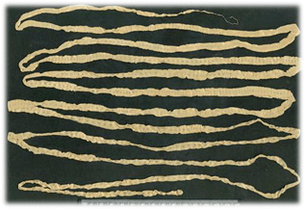
Trichinella is one of the smallest nematodes.The parasitic sizes barely reach 4 mm.Trichinelles adults parasitize in the small intestine and the larval stage in the transverse striped muscles, exclusion is the heart muscle.
A person is infected using infected animals - boars, pigs, bears, seals.For infection, just use 30-50 g of trichinelle meat.Most of the time, a person is infected with the use of meat, fat, ham, bacon, breasts, as well as sausages made of carcasses of infected animals.
Clinically the trichnelosis manifests by general symptoms of malaise, headache, fever at 38-39 ° C.
A little later, a pronounced edema of the eyelids or all the face appears, sometimes the swelling of the limbs occurs.These symptoms add muscle pain - calf, chewing, lumbar.Gradually, muscle pain intensifies, spread to new muscle groups.The patient's movements become increasingly limited, sometimes even complete immobilization.
The intoxication of the patient's body with the products of parasite's life leads to damage to the heart, lungs, brain and may be the cause of the patient's death.
Helminthiasis prevention
To avoid helminth infection, several rules must be followed, namely:
- Note the simplest rules of personal hygiene, including washing your hands after the street, before meals, after contact with money and animals.
- Try to avoid contact with stray animals and, if you have a pet, regularly visit a veterinary clinic.It is imperative to conduct animal dewitting courses with the frequency recommended by the veterinarian.
- Wash fruits, vegetables, berries well, even if they are of your personal plot.
- Do not drink water and do not wash the dishes and food with water, whose safety you are not sure.
- Eat only products that underwent the necessary heat treatment.
- Provide insect protection in your kitchen.For example, to enjoy the openings of the windows, cover ready -made dishes.
- Do not eat dry or dry homefish -fit.
- Do not use homemade salty lard.














